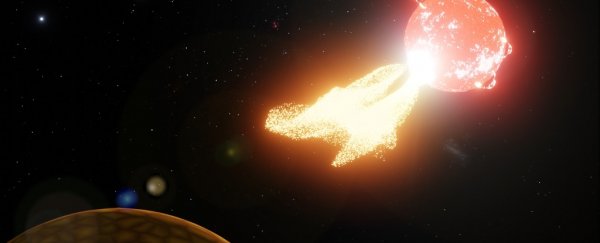We already had a bit of an inkling that our nearest stellar neighbour might be an inhospitable place. In 2017, red dwarf Proxima Centauri was caught belching out a colossal flare 10 times more powerful than the largest eruptions from the Sun, dampening hopes for habitable conditions on the rocky world orbiting it, Proxima Centauri b.
The outlook for life as we know it just got even more grim. A new discovery has given us evidence that Proxima Centauri may be releasing Sun-like coronal mass ejections, in which vast quantities of ionised plasma and electromagnetic radiation are launched into space, and which are much larger than flares.
"Astronomers have recently found there are two 'Earth-like' rocky planets around Proxima Centauri, one within the 'habitable zone' where any water could be in liquid form," said astronomer Andrew Zic of the University of Sydney in Australia.
"But given Proxima Centauri is a cool, small red dwarf star, it means this habitable zone is very close to the star; much closer in than Mercury is to our Sun. What our research shows is that this makes the planets very vulnerable to dangerous ionising radiation that could effectively sterilise the planets."
Proxima Centauri is Earth's nearest neighbour, just 4.2 light-years away. And the 2016 discovery of a rocky world (like Earth, Venus and Mars) in the star's habitable zone (close enough that water on the surface wouldn't freeze and not so close that it would vaporise) raised hopes that we might be able to find extraterrestrial life nearby.
But although red dwarf stars are small and cool, they have a tendency to be violent wee beasts. They lash their surroundings with frequent and powerful stellar flares, which scientists have interpreted as bad news for the possibility of life and habitability as we know it.
It's not the flares themselves that would necessarily be the problem, but coronal mass ejections. The two types of eruption often are linked in the Sun, with the most powerful flares accompanied by CMEs, and while solar flares can disrupt radio communications, it's CMEs that can cause the real problems, such as disrupting power grids. But we're relatively protected here on Earth.
"Our own Sun regularly emits hot clouds of ionised particles during what we call 'coronal mass ejections'. But given the Sun is much hotter than Proxima Centauri and other red-dwarf stars, our 'habitable zone' is far from the Sun's surface, meaning the Earth is a relatively long way from these events," Zic said.
"Further, the Earth has a very powerful planetary magnetic field that shields us from these intense blasts of solar plasma."
Planets orbiting red dwarf stars in close proximity may not be so lucky; even a magnetic field might not be enough protection.
However, although we've seen plenty of red dwarf flares, evidence for CMEs from red dwarf stars is scarce and subject to interpretation. Candidate CME-like behaviour identified in red dwarf stars, such as prolonged X-ray absorption, or blueshifted Balmer lines, could still be the product of flares.
Here in the Solar System, when the Sun releases a CME, it often releases a radio burst at the same time. Not to be confused with fast radio bursts, these low-frequency solar radio bursts are caused by different particle acceleration processes associated with the CME.
These bursts could indicate CME activity. But astronomers haven't detected many solar-like radio bursts from red dwarf stars. Prior to Zic's team's work, only one coherent solar-like burst had been recorded, all the way back in 1982; a handful of other detections were from single-dish telescopes, and therefore susceptible to terrestrial interference.
So Zic and his team set about looking for robust evidence of a radio flare from Proxima Centauri. They used the Zadko Telescope in Western Australia and data from NASA's TESS to obtain optical data, and the ANU 2.3m Telescope at Siding Spring Observatory for spectroscopic observations.
Meanwhile, the incredibly powerful radio telescope array of the Australian Square Kilometre Array Pathfinder (ASKAP) in the West Australian desert was used to take simultaneous observations in low-frequency radio.
And sure enough they caught a flare and a series of radio bursts. The simultaneous observations allowed the team to link the two events; with a probability of less than one in 128,000 that they weren't related.
The characteristics of the burst were very close to a solar burst Type IV. This is a type of long-duration burst that, for the Sun, is thought to be caused by the continuous injection of energetic electrons into post-flare magnetic structures following a CME.
"This is an exciting result from ASKAP. The incredible data quality allowed us to view the stellar flare from Proxima Centauri over its full evolution in amazing detail," said astronomer Tara Murphy of the University of Sydney.
"Most importantly, we can see polarised light, which is a signature of these events. It's a bit like looking at the star with sunglasses on. Once ASKAP is operating in full survey mode we should be able to observe many more events on nearby stars."
Although it's not direct evidence of a red dwarf CME, it's the most compelling evidence for a solar-like radio burst from another star to date, the researchers said. And, based on the properties of solar radio bursts, it seems very consistent with a CME.
"This is probably bad news on the space weather front. It seems likely that the galaxy's most common stars - red dwarfs - won't be great places to find life as we know it," Zic said.
The research has been published in The Astrophysical Journal.
